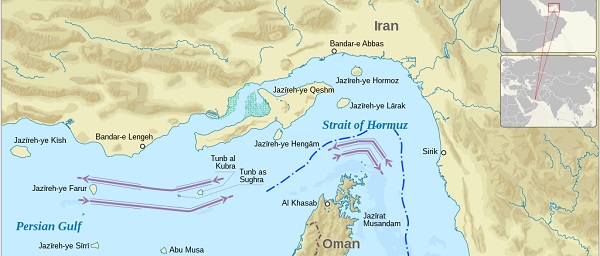conflict
How Iran Could Shake Up Global Economy In Response To US Strikes


From the Daily Caller News Foundation
By Audrey Streb
Iran is reportedly weighing blocking a key commercial choke point known as the Strait of Hormuz, a move that could drive up energy costs in the U.S. and across the globe, according to energy sector experts who spoke with the Daily Caller News Foundation.
Israel began to bombard Iran to eliminate the Islamic Republic’s ability to build a nuclear weapon on June 13, and the U.S. carried out “Operation Midnight Hammer” on Saturday night, bombing three of Iran’s nuclear facilities. While Iran’s parliament has reportedly voted to close the Strait of Hormuz in a retaliatory move to choke the world’s oil supply in response to the American strikes, the U.S. is well-positioned to combat the inevitable energy cost spike that would follow if Iran succeeds, sector experts told the DCNF.
“The escalating conflict between Iran and Israel is already putting upward pressure on oil and natural gas prices—and that pressure will intensify if the Strait of Hormuz is blocked,” Trisha Curtis, an economist at the American Energy Institute, told the DCNF. “This kind of disruption would send global prices higher and tighten supply chains. Fortunately, the U.S. is well-positioned to respond — our domestic production strength and growing export infrastructure make American oil and natural gas increasingly indispensable to global markets.”
Iran does not have the legal authority to halt traffic through the strait, meaning it would need to usurp control through force or the threat of force, according to legal scholars and multiple reports. The Iranian parliament’s reported move to block the Strait on Sunday awaits final approval by Iran’s Supreme Council, according to Iran’s Press TV.
The Strait is only 35 to 60 miles wide and connects the Persian Gulf to the Indian Ocean, flowing past Iran, the United Arab Emirates and Oman. The thoroughfare is vital for global trade, as tankers carried one fifth of the world’s oil supply through the Strait of Hormuz in 2024 and the first quarter of 2025, according to data from the U.S. Energy Information Administration.
Roughly 20 million barrels of oil pass through the Strait of Hormuz on a daily basis, Curtis noted. Some liquified natural gas (LNG) exports would also be blocked if the Strait of Hormuz were closed, she said.
Iran has reportedly been warning that it could close the strait for weeks, with one Iranian lawmaker and a member of the parliament’s National Security Committee presidium both quoted as saying that Iran could respond to enemy attacks by disturbing the West’s oil supply. Maritime agencies and the U.K. Navy have advised ships to avoid the Strait in recent weeks, given the potential threat.
Other energy experts pointed to how the Russia-Ukraine war led to a worldwide spike in energy costs.
“Energy markets do not like war — they particularly do not like war in the Middle East,” Marc Morano, author and the head of Climate Depot told the DCNF. Morano noted that the impact of the war did not immediately spike energy costs in the U.S. and abroad, though further escalation could spike them — especially Iran moving to block the Strait. “Even rumors of a blockade could instill fear into energy markets and drive prices up,” Morano said.
Despite the threat of shipping through the Strait of Hormuz being blocked, the U.S. has some cushion, given that it is a net exporter of oil and gas, according to energy sector experts.
President Donald Trump has promoted a pro-energy-growth agenda that paves the way for domestic oil and gas expansion, which positions the U.S. to withstand intense conflict escalations or even the closure of the Strait, energy sector experts told the DCNF.
Such a blockage would make US oil and gas exports more important. It underscores the importance of Trump’s agenda — to open Alaska and other areas to energy production, to speed up infrastructure permitting, and to increase exports to our allies,” director of the Heritage Foundation’s Center for Energy, Climate, and Environment Diana Furchtgott-Roth told the DCNF.
Though the U.S. still imports oil from some nations in the Middle East, including those that use the Strait of Hormuz, the U.S. has the capacity to become the dominant oil producer, energy sector experts told the DCNF.
If Iran were to close the Strait it would amount to “economic suicide” as the nation’s economy is reliant on Hormuz, both Vice President JD Vance and Secretary of State Marco Rubio said in interviews on Sunday.
James Taylor, president of the Heartland Institute, told the DCNF that any disruption in the oil markets would lead to price increases, which only highlights the need for pro-energy policies domestically.
“It is very important for American policymakers to support rather than impede American oil production because America, as a dominant energy producer, will be largely immune to such political crises,” Taylor said. “In fact, if America is a dominant oil producer and Iran takes steps to shock the oil markets, America would benefit and Iran’s nefarious plan would backfire.”
Artificial Intelligence
AI Drone ‘Swarms’ Unleashed On Ukraine Battlefields, Marking New Era Of Warfare


From the Daily Caller News Foundation
Artificial intelligence-powered drones are making their first appearances on the battlefield in the Russia-Ukraine war as warfare creeps closer to full automation.
In bombardments on Russian targets in the past year, Ukrainian drones acting in concert were able to independently determine where to strike without human input.
It’s the first battlefield use of AI “swarm” technology in a real-world environment, a senior Ukrainian official and Swarmer, the company who makes the software, told the Wall Street Journal in a Tuesday report. While drones have increasingly defined modern battlefields, swarms until now had been confined to testing rather than combat.
“You set the target and the drones do the rest,” Swarmer Chief Executive Serhii Kupriienko told the WSJ. “They work together, they adapt.”
So far, the Swarmer technology has been used hundreds of times to target Russia assets, but was first used a year ago to lay mines on the front, the Ukrainian official told the WSJ. The software has been tested with up to 25 drones at once, but is usually utilized with only three.
Kupriienko told the WSJ that he was preparing to test up to 100 drones at once with the linking software.
A common arrangement used on the battlefield includes one reconnaissance drone to scout out the target and two explosive drones delivering the payload on target, the official told the WSJ.
While Western nations such as the U.S., France and the United Kingdom are also pursuing drone swarm technology, they have not deployed swarm technology on the battlefield the way Ukraine has, according to the WSJ. Currently, autonomous weapons are not regulated by any international authority or binding agreement, but ethical concerns around the technology has led many to call for increased regulation of weapons like the Swarmer system.
The Ukrainian Ministry of Foreign Affairs did not immediately respond to the Daily Caller News Foundation’s request for comment.
conflict
Trump Pentagon Reportedly Blocking Ukraine From Firing Western Missiles Deep Into Russia


From the Daily Caller News Foundation
The Department of Defense has spent months blocking the Ukrainian military from using American and British-made missiles to hit targets deep inside Russia, The Wall Street Journal reported Sunday, citing unnamed U.S. officials.
Undersecretary of Defense for Policy Eldridge Colby reportedly designed the procedure to review requests to carry out the long-range strikes with weapons that are either of U.S. origin or that require American intelligence or use components provided by the U.S., according to the WSJ. Secretary of Defense Pete Hegseth reportedly has the final say on whether Ukrainian forces can use the MGM-140 ATACMS (Army Tactical Missile System) to hit targets in Russia.
The reported blocks on missile strikes coincides with a Trump administration effort to broker a peace deal between Russia and Ukraine. A Pentagon spokesperson declined to comment further on the matter.
BREAKING: President Vladimir Putin reacts to B-2 Flyover pic.twitter.com/1mzVn7DxlW
— Jack Poso 🇺🇸 (@JackPosobiec) August 15, 2025
The Biden administration allowed Ukraine to carry out strikes with ATACMS in November, weeks after President Donald Trump won the 2024 election, the New York Times reported. Trump criticized the move during a December interview with Time magazine.
“It’s crazy what’s taking place. It’s crazy,” Trump said. “I disagree very vehemently with sending missiles hundreds of miles into Russia. Why are we doing that? We’re just escalating this war and making it worse. That should not have been allowed to be done.”
Trump and Russian President Vladimir Putin met in Alaska on Aug. 15 for a summit meeting during which Trump sought to secure a cease-fire in Russia’s war with Ukraine. As Trump greeted Putin, a B-2A Spirit stealth bomber and several fighters carried out a flyover of Elmendorf Air Force Base.
Trump met with Ukrainian President Volodymyr Zelensky and major European leaders on Aug. 18 to update them on the summit.
In July, Trump reached an agreement with NATO where members of the alliance would purchase weapons, including MIM-104 Patriot surface-to-air missiles, and donate them to Ukraine.
-

 espionage2 days ago
espionage2 days ago24 years later: Tucker Carlson releases interview with retired CIA agent claiming the CIA KNEW 9/11 was coming
-

 Business2 days ago
Business2 days agoWEF has a plan to overhaul the global financial system by monetizing nature
-

 Autism2 days ago
Autism2 days agoSecretary Kennedy’s Key Remark at Autism Press Conference
-

 Alberta2 days ago
Alberta2 days agoAlberta pro-lifers demand protections for infants born alive after failed abortions
-

 Autism2 days ago
Autism2 days agoTrump Blows Open Autism Debate
-

 Crime2 days ago
Crime2 days ago1 dead, 2 injured after shooting at Dallas ICE facility
-

 Daily Caller2 days ago
Daily Caller2 days agoTrump’s Ultimatum To Europe On Russian Oil
-

 Energy2 days ago
Energy2 days agoBig Tech’s ‘Misleading’ Green Energy Claims May Plunge Nation Into Blackouts, AGs Warn






